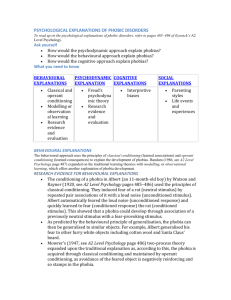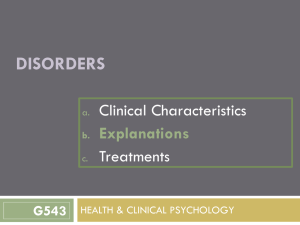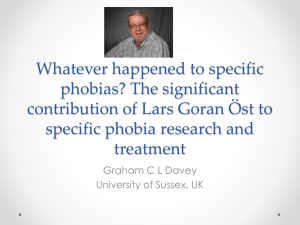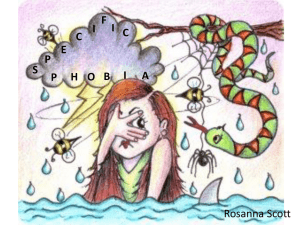Booklet: Explanations
advertisement
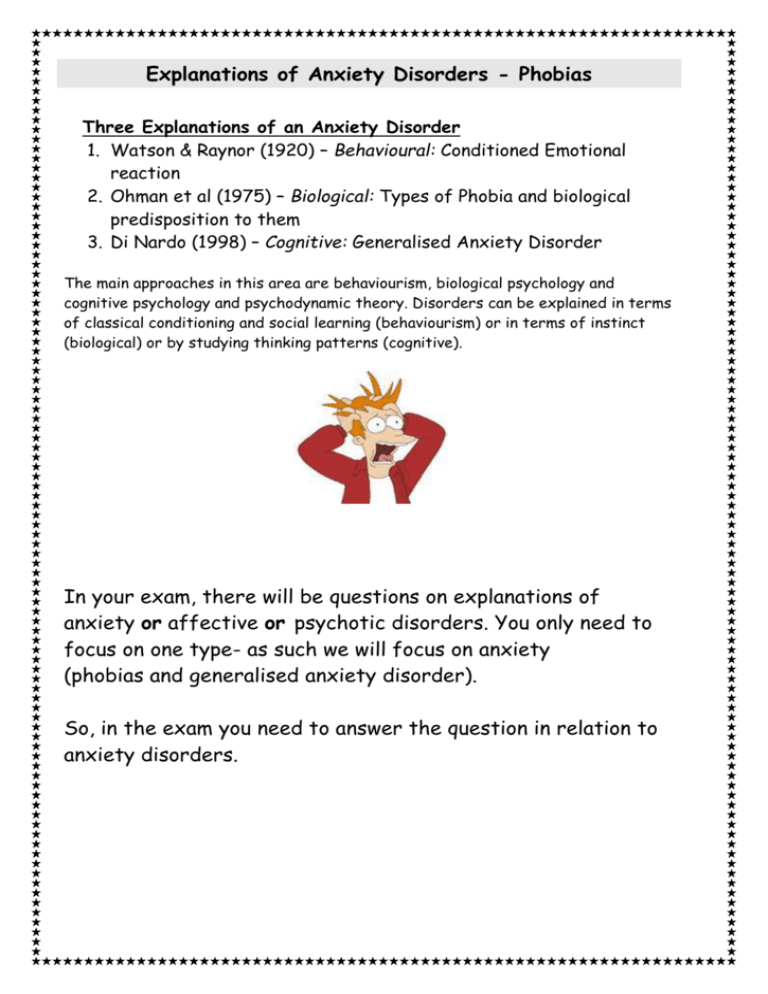
Explanations of Anxiety Disorders - Phobias Three Explanations of an Anxiety Disorder 1. Watson & Raynor (1920) – Behavioural: Conditioned Emotional reaction 2. Ohman et al (1975) – Biological: Types of Phobia and biological predisposition to them 3. Di Nardo (1998) – Cognitive: Generalised Anxiety Disorder The main approaches in this area are behaviourism, biological psychology and cognitive psychology and psychodynamic theory. Disorders can be explained in terms of classical conditioning and social learning (behaviourism) or in terms of instinct (biological) or by studying thinking patterns (cognitive). In your exam, there will be questions on explanations of anxiety or affective or psychotic disorders. You only need to focus on one type- as such we will focus on anxiety (phobias and generalised anxiety disorder). So, in the exam you need to answer the question in relation to anxiety disorders. 1. Behavioural Explanations Phobias are seen as learnt behaviour, either through classical conditioning, operant conditioning or social learning theory. Classical Conditioning – Watson & Rayner (1920) conditioned a baby boy known as Little Albert to fear white rats. For several weeks, Albert played happily with a white rat showing no fear. One day, while he was playing with the rat, the experimenters struck a steel bar with a hammer close to Albert’s head. Albert was very frightened by the noise. This was repeated each time he reached for the rat. Albert then developed an intense fear of white rats UCS = Unconditioned stimulus UCR = Unconditioned response (Natural) CS = Conditioned stimulus CR = Conditioned response (Manipulated) UCS (Noise) UCS (Noise) + CS (Rat) CS (Rat) UCR (Fear) UCR (Fear) CR (Fear) This explanation sees the origin of phobias as through linking two things together even though there is no logical, nor causal connection between them. (and Dr. Watson!). 1. Watson & Raynor (1920) – Behavioural: Conditioned Emotional reaction Aim: To see if it is possible to induce a fear of a previously unfeared object through classical conditioning. To see if the fear will be transferred to other similar objects. To see what effect time has on the fear response. To see how possible it is to remove the fear response in the laboratory. Approach/Perspective : Behavioural Method: A case study undertaken on one boy: ‘Little Albert who was 8 months old and lived in the hospital with his mother, a nurse. He was ‘stolid and unemotional’. A single subject design. Details: See notes on previous study on Little Albert in Dysfunctional Conclusions: Session 2 – After five paired presentations the conditioning of a fear response was evident and so it is possible to condition fear through classical conditioning. Session 3 and 4 – Transference of the fear had been made to other similar objects, although it appeared the less like the original stimulus the objects were (e.g. the cotton wool), the less negativity was shown. Session 5 – Time had not removed the fear response. Unfortunately Albert was taken out of the hospital on the day of Session 5, so Watson and Rayner were never able to carry out their aim of trying to find ways of removing a phobia in the laboratory. We don’t know if Albert had a fear of furry animals for the rest of his life! Research by Mary Cover Jones on Little Peter, (Jones, 1924) did show how a fear of rabbits could be overcome using a treatment of systematic desensitisation. Notes: Operant conditioning also provides am explanation for acquiring and reinforcing a phobic behaviour. i.e Child in bed hears thunder runs to parents room, safe and comforting. Next time thunder comes what are they going to do? Stay lonely in bed or go to parents for comfort. Realise get cuddles if frightened of thunder so continue to show fear. Behaviour becomes entrenched and fear reaction becomes an automatic response. SLT- Bandura discovered p’s would develop fear of buzzer if saw someone else in pain when it sounded. 2.Ohman et al (1975) – Biological: Types of Phobia and biological predisposition to them Background: based on assumption that a disorder has a biological cause. Mental disorders are same as physical disorders just located in diff place in the body. Mental disorders can be treated in same way as physical illness, mainly with drugs. This explanation sees phobias as serving an evolutionary purpose – so for example a fear of snakes helps people to save their lives. This even introduces a genetic element. Ost (1992) found 64% of people with blood and injection phobia had a first degree relative who shared the same disorder. Seligman’s research on preparedness suggests many phobias may have originally been based on instinctive responses to danger, to things that could threaten human survival. This is because we have evolved with a fear of things that could harm us,(simplified evolutionary theory). Ohman set out to show how easier to induce phobias of snakes rather than nonthreatening items such as faces or houses and Ohman 1975 was more able to use classical conditioning to cure people with fears of houses and flowers than of spiders or snakes, this could be taken as supporting Seligman’s preparedness theory. Aim: To see if phobias of snakes could be more easily conditioned than phobias of faces or houses, indicating a biological preparedness to develop phobias of certain objects Approach: Behaviourist Method: Laboratory experiment, with participants linked to a machine that would present pictures and then deliver shocks after some of them. Their fear reaction was measured by skin conductance. Independent design with participants being in one of three conditions. Electric shocks were given after presentation of snakes, houses or faces.64 paid volunteers aged 20– 30 years. There were 38 females and 26 males and they were all psychology students from the University of Uppsala in Sweden Details: Each participant was wired up to a machine that would measure their skin conductance. They were given a shock at a level that they as an individual rated as definitely uncomfortable but not painful. Pictures were presented on coloured slides for 8 seconds and, if they were going to be given a shock, it occurred immediately as the picture was shown. Participants were seated comfortably and told that they would experience a number of shocks and that they would see three different types of pictures: snakes, human faces and houses. The order of the pictures was randomised. 32 participants received shocks after the snakes and of the other 32, 16 received shocks after pictures of houses, and 16 received shocks after pictures of human faces Results; All participants had a similar measure of skin conductance prior to the conditioned stimulus (shock) being presented. After the presentation of the shocks with the pictures the responses were as follows: Participants shown snakes had on average .062 conductance to the snakes and .048 conductance to the houses and faces. The higher the conductance the more they were sweating, which is a physiological response to fear. The control groups who were shocked after faces or houses showed only .037 conductance to their conditioned stimuli (houses or faces) and .030 to the neutral stimuli that didn’t appear with shocks. N.B. the unit of measurement was micro mhos, which is a measure of conductance of electricity. Conclusions: Participants were more likely to show fear reactions to snakes than houses or faces. This shows a biological preparedness to develop phobias to objects that may cause us danger, such as snakes. For genetic explanation it is important to realise that people do not inherit a specific gene for an illness, such as depression, rather, people inherit the vulnerability to it. Activity Fred Flintstone has a phobia of dinosaurs - explain in your own words how this phobia could be explained in terms of biology Explanation 3.Di Nardo (1998) – Cognitive: Generalised Anxiety Disorder Background: Cognitive explanations see the origin of phobias in faulty thinking – concern about some issues that are threatening is perfectly rational, but excessive and disproportionate anxiety is not. So a bad experience may lead to negative thoughts which lead to fear, so the negativity and the fear feed on themselves leading to poor thinking and an inability to cope properly when parallel situations crop up subsequently. DiNardo (1988) studied people who had a traumatic experience with dogs; some developed a phobia of dogs, others did not. Those who developed phobias were more likely to believe that they would have a similar negative experience in the future. Phobias can be maintained or made worse by the way people think about their situation. A high level of anxiety may lead to catastrophising – imagining the worst possible outcome of every situation whilst ignoring the possibility of positive outcomes. Di Nardo found only half people who had had a traumatic experience with dog develop a phobia therefore, they must interpret the event differently from those with phobias. (Faulty thinking pattern.) Aim: To assess whether ‘excessive worry’ is a symptom of General Anxiety Disorder (GAD) Approach/Perspective: Cognitive Method: Quasi-experiment covering three clinics in the USA. Independent design. Patients with and without diagnoses of GAD. Procedure Patients were interviewed twice to assess the reliability of using two different structured interviews. The frequency of the symptom ‘excessive worry’ was analysed along with the percentage of day for which the patient said they displayed the symptom. Results; Significantly more patients with GAD reported excessive worry than non-patients. More patients without GAD reported no-excessive worry. Patients with GAD reported excessive worry for 59.1% of the day compared with 41.7% of non-GAD patients. Conclusions: Excessive worry, which indicates faulty thinking, is found in more GAD patients. Its absence can be used to rule out a diagnosis of General Anxiety Disorder. Patients with GAD spend more time each day worrying. Summary: Explanations of Disorders As you can see there are many different approaches to explaining anxiety disorders Each approach has some relevance to our understanding It might be useful to adopt an eclectic approach and use parts of each of these to fully understand phobias. Psychodynamic and social may have different explanations All the explanations have their strengths and weaknesses, some are better at explaining some disorders than others. It is important to remember that human behaviour, including dysfunctional behaviour has MANY causes, some of which we still have to identify. Comprehension questions Explanations of Disorders 1. Watson & Raynor (1920) – Conditioned Emotional reaction How would the behavioural approach explain how phobias develop? What was Albert’s first response to the rat? Explain whether this fits in with the situational or individual debate? This approach is thought of as highly scientific. Why? Think of a negative issue for this study and explain it? 2. Ohman et al (1975) – Types of Phobia and biological predisposition to them What is biological preparedness? What were the phobic objects to be conditioned in Ohman et al’s study on phobias and preparedness? What were the three conditions of the study? How did the researchers measure the fear reaction? Explain whether this fits in with the situational or individual debate? 3. Di Nardo (1998) – Generalised Anxiety Disorder (Cognitive Explanation) How does this explanation explain a phobia? What is GAD? What was Di Nardo’s aim? What did he conclude? Think of a debate which links to this study? Behavioural & Cognitive Explanations of Phobic Disorder BEHAVIOURAL EXPLANATIONS The behavioural approach uses the principles of classical conditioning (learned associations) and operant conditioning (learned consequences) to explain the development of phobias. Bandura expanded on the traditional learning theories with modelling, or observational learning, which offers another explanation of phobia development. RESEARCH EVIDENCE FOR BEHAVIOURAL EXPLANATIONS The conditioning of a phobia in Albert (an 11-month-old boy) by Watson and Rayner (1920, see A2 Level Psychology pages 485–486) used the principles of classical conditioning. They induced fear of a rat (neutral stimulus) by repeated pair associations of it with a loud noise (unconditioned stimulus). Albert automatically feared the loud noise (unconditioned response) and quickly learned to fear (conditioned response) the rat (conditioned stimulus). This showed that a phobia could develop through association of a previously neutral stimulus with a fearprovoking stimulus. As predicted by the behavioural principle of generalisation, the phobia can then be generalised to similar objects. For example, Albert generalised his fear to other furry white objects including cotton wool and Santa Claus’ beard. Mowrer’s (1947, see A2 Level Psychology page 486) two-process theory expanded upon the traditional explanation as, according to this, the phobia is acquired through classical conditioning and maintained by operant conditioning, as avoidance of the feared object is negatively reinforcing and so stamps in the phobia. 50% of people being treated by Barlow and Durand (1995, see A2 Level Psychology page 486) for driving phobia recalled a traumatic incident that triggered the phobia, so supporting classical conditioning. Similarly, nearly everybody they were treating for choking phobia linked this to an experience of choking. Hackmann, Clark, and McManus (2000, see A2 Level Psychology page 486) found that 96% of social phobics remembered some socially traumatic experience that had happened to them (often in adolescence). For example, they were harshly criticised in public or couldn’t stop blushing on an important social occasion. Bandura (1986, see A2 Level Psychology page 487) proposed that phobias could also be developed through observational learning, modelling, and direct reinforcement. Evidence of modelling was found in monkeys that developed snake phobia by observing another monkey’s fearful reaction to a snake (Mineka et al., 1984, see A2 Level Psychology page 487). Also, Merckelbach et al. (1996) reported evidence that modelling and negative information transmission are important in producing smallanimal phobias and blood-injection-injury phobia. RESEARCH EVIDENCE AGAINST BEHAVIOURAL EXPLANATIONS According to the principles of classical conditioning, the association is extinguished if the bonds cease. Thus, the phobia should not persist over time, although Mowrer’s (1947, see A2 Level Psychology page 486) expanded explanation can account for this. Phobias of neutral stimuli cannot be as easily conditioned as the Albert experiment suggests. Attempts to condition phobias of neutral stimuli using electric shocks in the laboratory have had little success (Valentine, 1946, see A2 Level Psychology page 488). Approximately half of all phobics cannot recall a highly unpleasant experience with the feared object (Keuthen, 1980, see A2 Level Psychology page 487). DiNardo et al. (1988, see A2 Level Psychology page 487) reported that 50% of dog phobics had an unpleasant encounter but about 50% of normal controls had also had such experiences and did not develop a phobia. Behaviourism ignores cognitive factors and so cannot account for individual variation. The fact that not all phobics have had a bad experience and some non-phobics have had a bad experience and not developed phobia is probably due to the patients’ perception and interpretation, and so cognitive rather than behavioural factors are important. There are only a few well-documented cases where social learning had clearly led to phobia. EVALUATION OF BEHAVIOURAL EXPLANATIONS Ethical issues. Protection of participants was clearly an ethical issue in the Albert study, which the researchers acknowledged but felt was justifiable because children experience fearful situations in daily life. However, whether the ends justify the means is debatable, particularly given that the validity of the study can be questioned. Face validity. Learning from experience and social learning theory do make sense and the latter is particularly convincing as children do imitate their parents’ responses and parents do reinforce fear responses, e.g. of traffic. Reliability. The research evidence on whether phobias result from a traumatic experience, and so classical conditioning, is very inconsistent and so lacks reliability. Also, attempts to replicate Watson and Rayner’s research have been unsuccessful. This casts doubt on the validity of the explanation and shows that not all phobias can be explained by conditioning. Perhaps their findings are due to the fact that Little Albert was an 11-month-old child and easier to condition as he would be less influenced by cognitive factors (ignored by the theory) than adult participants. Retrospective. The fact that bad experiences of the phobic object are not remembered could be due to poor recall as retrospective data is subject to error. Or the memory could have been repressed if it was particularly traumatic. This supports the validity of conditioning as an explanation, as it may be that frightening experiences have initiated the phobia but that these have not been remembered. Reductionism. Behavioural explanations are oversimplified because they only account for learning and ignore other important factors such as cognition and biological preparedness. Environmental determinism. The behavioural explanations are deterministic because they suggest that behaviour is controlled by the environment, which ignores the individual’s ability to control their own behaviour. Nature vs. nurture. Behavioural explanations account for nurture only as, according to these, behaviour is solely a product of learning as we are born as a blank slate (tabula rasa). They ignore nature, which is a significant weakness as the evolutionary explanation suggests certain objects are more likely to be conditioned than others. Multi-dimensional approach. As not all phobias can be explained by conditioning and social learning, other processes must be involved, such as biological preparedness as suggested by the evolutionary approach. So to understand phobias an interaction of different factors must be considered. COGNITIVE EXPLANATIONS The cognitive approach suggests that cognitive biases underpin phobias. Phobics employ interpretive biases, which means they are more likely to perceive ambiguous stimuli as threatening and harmful to themselves than others would. This has face validity as it does account for the high level of anxiety reported by phobics and it makes sense that people with anxiety disorder find the world a threatening place. RESEARCH EVIDENCE FOR COGNITIVE EXPLANATIONS Empirical support is provided by Thorpe and Salkovskis (1995, see A2 Level Psychology page 490) who found spider phobics had a number of interpretive biases compared to non-spider phobics when asked to imagine a spider was in the room with them. Kamieniecki, Wade, and Tsourtos (1997, see A2 Level Psychology page 491) presented participants with ambiguous scenarios relating to bodily sensations. Patients who had panic disorder with agoraphobia produced more anxiety-related interpretations of these scenarios, which is consistent with the typical clinical finding that patients mistakenly believe that a panic attack means they may well have a heart attack and die. Rapee and Lim (1992, see A2 Level Psychology page 492) provide evidence for similar interpretive biases in social phobics. They asked social phobics to give a public talk and then asked observers and the participants themselves to rate their public-speaking performance. Social phobics rated their performance as much worse than did the observers. EVALUATION OF COGNITIVE EXPLANATIONS Phobics do have cognitive biases. This makes the explanation highly plausible. Descriptive rather than explanatory. However, a key weakness is that the cognitive explanation is descriptive rather than explanatory. It describes the thought patterns experienced rather than explaining how or why they developed in the first place. Cause and effect. Hackmann et al. (2000, see A2 Level Psychology page 492) found that 96% of social phobics recalled a socially traumatic event that may have helped to trigger the social phobia, which supports a behavioural origin to the phobia. But of course behaviourism doesn’t account for cognition so the two explanations combined into a cognitive-behavioural account would provide a better understanding of phobias. Furthermore, it is not clear whether the cognitive biases precede or follow the disorder, so cause and effect is an issue.

